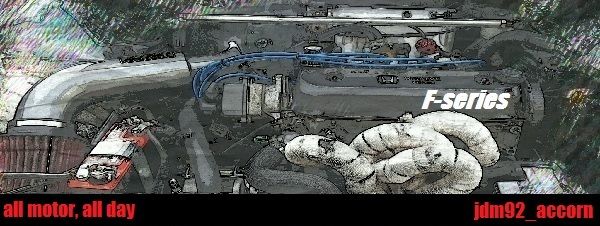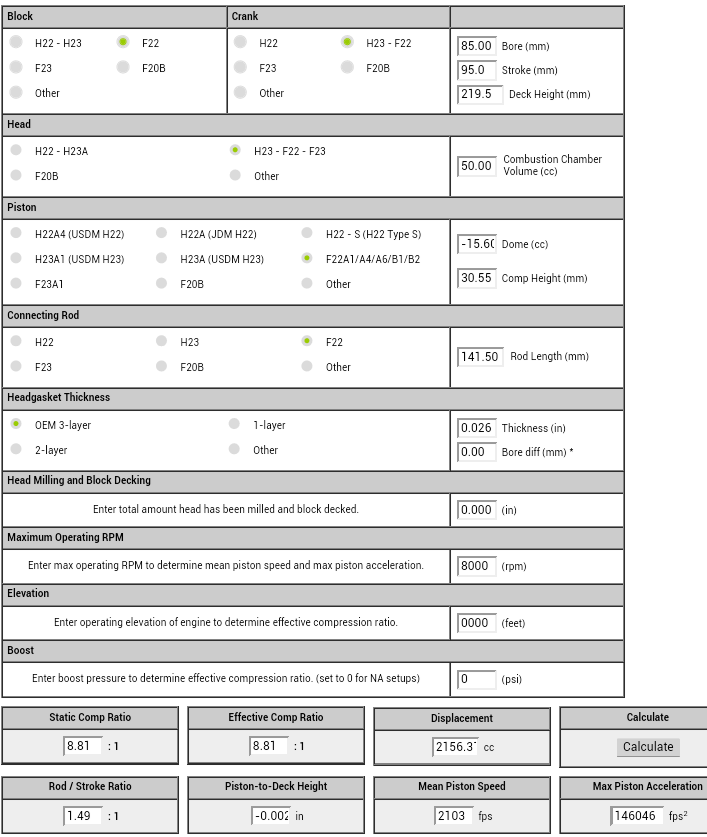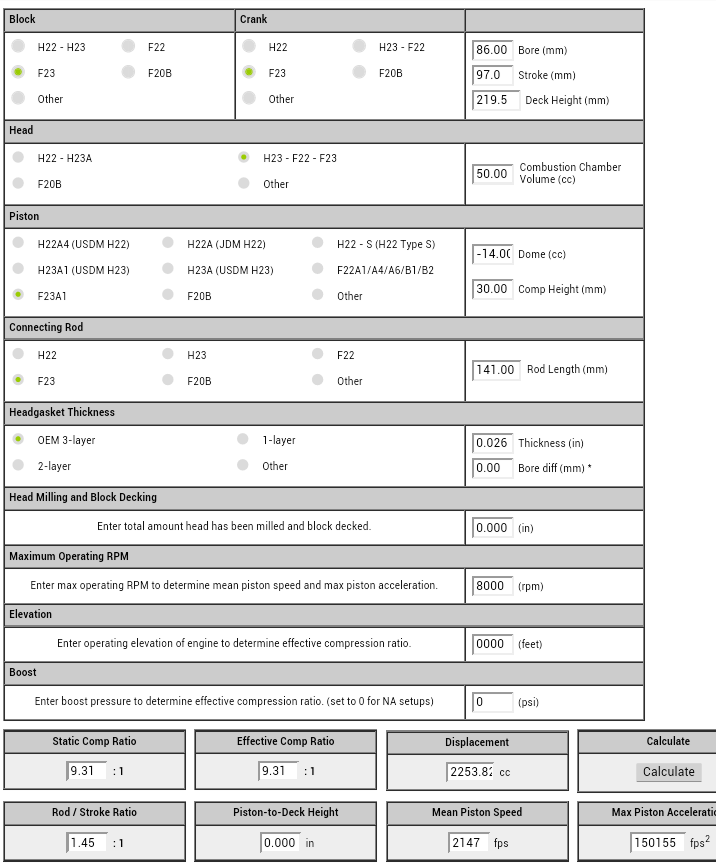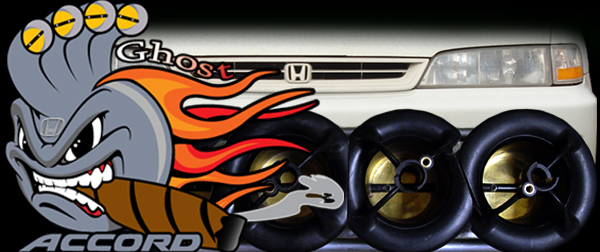it is the only reason i got the engine is for the bottom end, lol. the cr is 9.3:1 but with my milled head it will be 9.7:1 just like with the f23 bottom end. im curious to see the power difference between the two.
Announcement
Collapse
No announcement yet.
jdm92_accorn : 1992 Accord LX
Collapse
X
-
Don't mean to sound like a know it all, but its impossible for it to be 9:3:1, that's the same as the F23. I know that Wikipedia says that but its gotta be 9:5:1. That is what this says,Originally posted by jdm92_accorn View Postit is the only reason i got the engine is for the bottom end, lol. the cr is 9.3:1 but with my milled head it will be 9.7:1 just like with the f23 bottom end. im curious to see the power difference between the two.
http://honda-tech.com/showthread.php?t=612451
Then it takes you to this Japanese Honda site:
http://www.honda.co.jp/factbook/auto.../pr91-022.html
Just by looking at the two the F23 has a larger dish than it does. Here's my block tore down:

Yours has a flatter piston. Flatter piston = more compression:

So be sure to change your equation for compression, its not the same as an F23.Last edited by Mishakol129; 02-28-2014, 01:56 AM.“Speed has never killed anyone. Suddenly becoming stationary, that's what gets you.”
― Jeremy Clarkson
Very first tear down and rebuild. vvv
http://www.cb7tuner.com/vbb/showthread.php?t=193755"]http://www.cb7tuner.com/vbb/showthread.php?t=193755"]http://www.cb7tuner.com/vbb/showthread.php?t=193755
Current Build, F23 block F22b dohc head:
http://www.cb7tuner.com/vbb/showthread.php?t=203144
Comment
-
I don't understand why you are using an online calculator that will give you an approximate static compression ratio when you have the engine torn apart right there. Have ether of you measured the actual volume of any of these parts?
FYI, a flatter piston only gives you more compression if everything else in the cylinder head and bore, that are being compared, are the same volume.
I know when I physically measured all of my parts they are a bit off from these numbers. Just a heads up! Considering Mishakol129 is arguing a very small 0.2 points of compression difference. besides that, it stats the following right at the top of the Zeal Autowerks calculator page;Originally posted by zealautowerks.comThis calculator is intended for use as a general estimate of your compression only. Not all values are verified.Last edited by GhostAccord; 02-28-2014, 03:21 PM.
Comment
-
No I measured with a surrenge and a 1" thick plexiglass plate I made. I got 50cc on the combustion chamber and -11.54cc on the piston this coupled with the actual block bore and gasket dimensions puts total combustion chamber size at 65.4cc at tdc and 608.2cc at bdc I got 9.3:1. The zeal calculator just gives a visual for most to better understand it. You and I, ghost, both understand that not all 8.8:1 f22's are actually 8.8 exactly. It just so happens the motor I got was clean enough to wipe off the pistons and get a good measurement. The zeal calculator has been fairly accurate on the f-series just not so much on the k-series and d-series.
Comment
-
Yeah I was pretty sure that you measured your parts. I also know for a fact the other party mentioned has never measured anything engine related. He uses Google and 12 year old threads as a measuring tool to base his builds off.
Just to put this into perspective for you Mishakol129; It only takes a difference of 2cc's in the combustion chamber volume to make up 0.2 points of compression. 2cc's that's it! That is pretty much the difference between having 4 valves with flat faces vs dished faces.Last edited by GhostAccord; 02-28-2014, 04:48 PM.
Comment
-
3cc is bang on according to the math. The volume removed by milling an 85mm chamber 0.02" is 2.89cc.
I'll be taking about 12cc from each of my combustion chambers. I had originally thought about adding some weld to the combustion chamber. However after taking a closer look. It really isn't beneficial to add material on these combustion chambers with my pistons.
Comment
-
Regardless of the measurements of the piston, the slightly larger bore or combustion chamber volume, I rarely see it taken into account the impact that the stroke has on a engine's compression ratio. The further down the throw of the crankshaft can go, the more volume that there will be in a cylinder at BDC.
It's staggering how many of the people putting 93mm J35A crankshafts into their J32A2s (10.5:1 CR with 86mm stroke) are convinced that J35A8 pistons from the 2005-2008 RL and 2007-2008 TL Type-S (11.0:1 CR with 93mm stroke) will cause them to have the 11.0:1 CR instead of the 10.5:1. If you take those same pistons that would have done 10.5:1 with an 86mm stroke and cause the new BDC point to take in an additional 7mm of travel's worth of air then it will now have a higher compression ratio. It's not a number, but a comparison of two numbers. Even though your TDC volume hasn't changed, the amount of air you're cramming into it has.
That example is an easy one because regardless of the stroke the compression heights are the same for all J-series engines.My Members' Ride Thread - It's a marathon build, not a sprint. But keep me honest on the update frequency!
Comment
-
Once you have a tdc volume the bdc volume won't be different with different rod length and compression height as long as the piston to deck height is the same. I.E., the rod could be 141.5mm, compression height 30.55mm and a stroke of 95mm with p2d height of .002" out of the block, then you switch to a 143mm rod, use a 29.05mm compression height piston on the same 95mm stroke and keep the same bore size, dish/dome and same p2d height compression ratio is unchanged because the piston will still only go down the bore 95mm.
Comment
-
That's exactly what I was getting at!Originally posted by jdm92_accorn View PostOnce you have a tdc volume the bdc volume won't be different with different rod length and compression height as long as the piston to deck height is the same. I.E., the rod could be 141.5mm, compression height 30.55mm and a stroke of 95mm with p2d height of .002" out of the block, then you switch to a 143mm rod, use a 29.05mm compression height piston on the same 95mm stroke and keep the same bore size, dish/dome and same p2d height compression ratio is unchanged because the piston will still only go down the bore 95mm.
I'm not that familiar with the J series engines or if they have the same deck height or bore. However, all things being equal. The J32A2 with a longer stroke 93mm crank and RL/TL-S rods and pistons should net 11:1CR.
Comment
-
All J-series engines, from the J25A to the J37A, use the same deck height and the same 30mm compression height.Originally posted by GhostAccord View PostThat's exactly what I was getting at!
I'm not that familiar with the J series engines or if they have the same deck height or bore. However, all things being equal. The J32A2 with a longer stroke 93mm crank and RL/TL-S rods and pistons should net 11:1CR.
The comparison of the J32A2 and J35A8 was even because those two engines also share the same 89mm bore.
The hypothetical that you give with the entire rotating assembly is true. However, there's nothing different about it than a stock J35A8. You taken all of the rotating assembly components and put them into an identical environment.
Think about it. If you have an engine with a somewhat short stroke, say 86mm, then its volume at BDC will not be very high. So, in order to increase the amount of energy that the engine can create from that amount of air you must compress it much more than you would have otherwise. Let's say that it takes a piston with a 4.25cc dome to get an 11.0:1 compression ratio. Now take that 86mm crankshaft out and replace it with one with a 99mm stroke. To get the TDC height back to the same we'll need a 132.5mm rod. In that combination the engine now produces a 12.5:1 compression ratio. If the piston profile, the combustion chamber and final height at TDC are all the same between combinations then the added stroke greatly increases the amount of air at BDC that is being compared with the ratio.
With the J32A2, the piston that does 10.5:1 in an 86mm stroke will actually do something closer to 11.3:1 with a 93mm stroke.
Sorry to go off topic. Just had fun with the conversation.My Members' Ride Thread - It's a marathon build, not a sprint. But keep me honest on the update frequency!
Comment







Comment